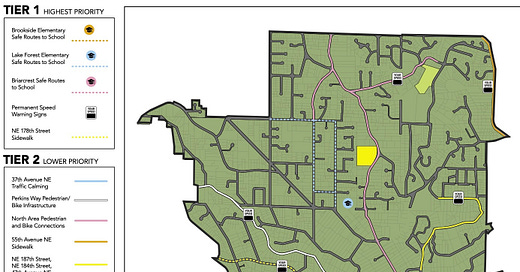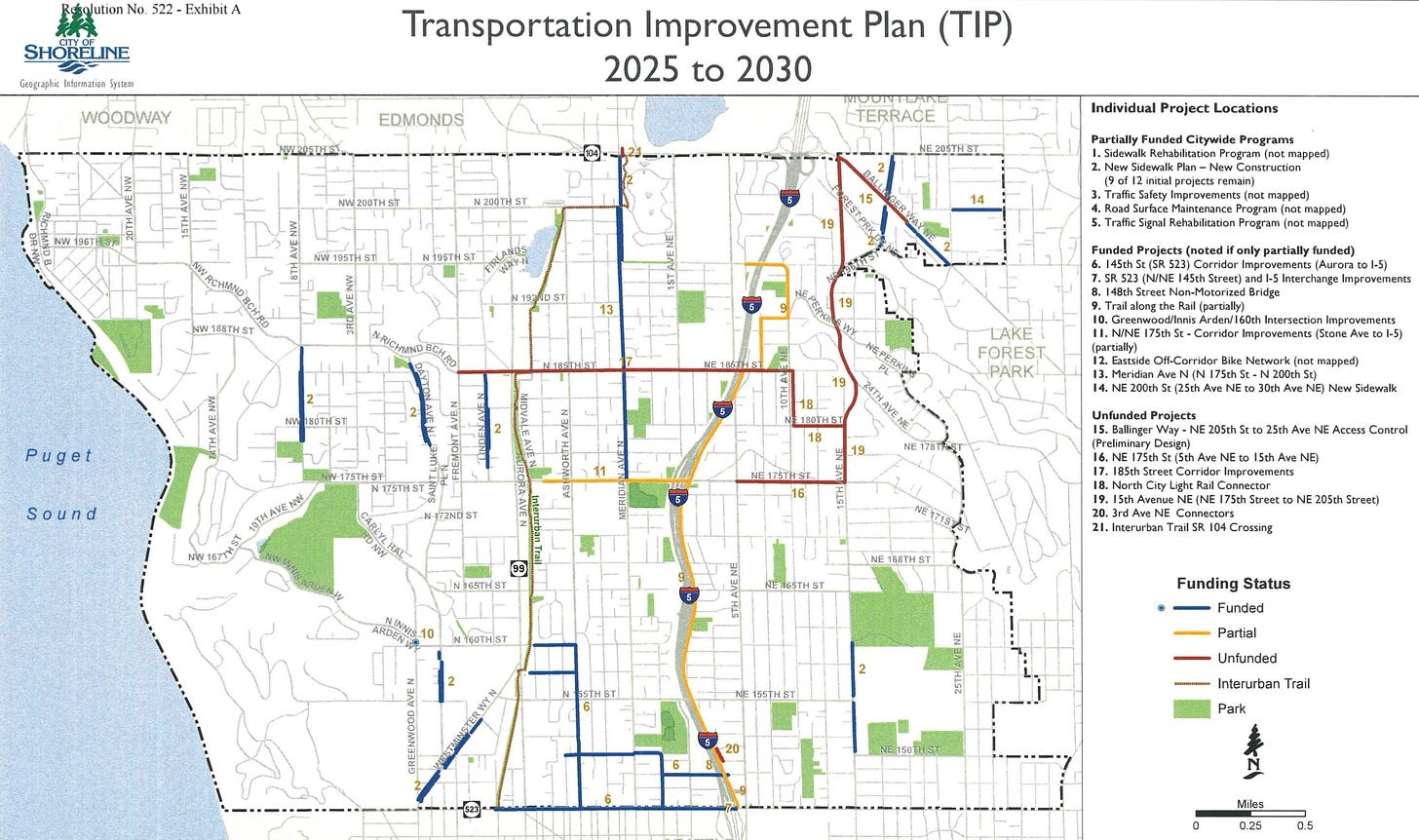Shoreline and Lake Forest Park take different pedestrian safety routes
Last year was the deadliest year on record for pedestrians. Comparing the budgets for Shoreline and Lake Forest Park’s shows differing strategies for addressing pedestrian safety.
Fueled by tens of millions of dollars in grants, Shoreline plans to spend $96 million on pedestrian projects while Lake Forest Park - facing a $3 million deficit - turns to automated cameras to slow speeders and curb reckless drivers.
Area roads are more dangerous than ever. According to Shoreline’s annual Traffic Report, the number of pedestrian crashes hit a record high last year and the Washington Traffic Safety Commission says more pedestrians were killed in Washington State last year than in any other year on record.
A map from the levy LFP voters rejected in 2021 shows the locations of possible pedestrian safety projects
Out of Lake Forest Park’s $7.5 million transportation fund, $7 million will be spent to build a roundabout at the intersection of Ballinger Way (SR 104) and 40th Place NE. The city received grants from the state to pay for half of the roundabout. Studies have shownroundabouts improve safety for pedestrians. The city also plans to spend another $200,000 from the transportation fund to design and construct wheelchair accessible sidewalk ramps.
But with the city expecting to end the 2025-2026 biennium with a $3 million deficit, Lake Forest Park has turned to automated traffic safety cameras to slow speeders and transform dangerous roads into safe streets for pedestrians. The city first deployed traffic cameras in 2009 and now operates red light cameras on Bothell Way and speed cameras at its two elementary schools. Revenue from those cameras are expected to generate $4,381,800 in revenue for the city’s general fund.
A new state law allowed the city to leave the cameras at Brookside elementary on 178th Street turned on year-round and all-day, even when school is not in session. After the city turned on the traffic cameras on 178th all day in June, average speeds dropped from over 30 mph to less than 25 miles per hour. At an August 5 city council meeting, Lake Forest Park Mayor Tom French said, “the average speed in the 178th zone prior to the installation of the 24/7 traffic cameras was over 30 miles an hour.” After 60 days, “it is down now to 24.3 miles an hour. It's below 25 miles an hour, so by any metric it has been an enormous success,” he said.
According to the city’s budget, the new traffic cameras on 178th will generate over $8 million in revenue over the next two years. But the new state law requires the city to spend those funds on traffic safety improvements after paying operating costs (the city was previously allowed to deposit the revenue into the general fund).
The budget does not say which traffic safety projects the city will fund with the millions of dollars it expects to collect. A levy for parks and sidewalks that LFP voters rejected in 2021 would have collected about $2 million annually to pay for a network of sidewalks across the city - especially near schools.
Unlike neighboring cities, Shoreline has resisted adoption of traffic cameras and earlier this year, parents from Meridian Park Elementary brought a petition with 180 signatures asking the Shoreline city council to install speed cameras on 175th street in front of Shoreline’s largest elementary school.
A map from Shoreline’s Transportation Improvement Plan shows the locations of funded and unfunded projects.
Instead, the city will spend tens of millions of dollars on infrastructure. Shoreline’s proposed Capital Improvement Plan names $95,956,157 worth of “Pedestrian / Non-Motorized Projects” over the next six years, accounting for roughly 30% of its $321,138,986 total transportation budget. One third of Shoreline’s revenue for capital projects will come from federal and state grants.
In total, the city plans to spend $87,235,306 (mostly from state and federal grants) on the 145th Street Corridor from the light rail station east of I-5 to Linden west of Aurora. The project will widen the roadway to add accessible shared-use paths to replace the existing narrow strips of pavement. The city will spend $39,012,986 to build the 148th Non-Motorized Bridge over the next two years with more than 98% of that coming from regional, county, state and federal grants.
In 2018, a ballot measure approved by Shoreline voters raised sales tax by 0.2% to pay for 12 new sidewalks and the city council increased vehicle license fees by $20 to fix existing sidewalks that are unsafe and inaccessible to people using wheelchairs. According to the budget, over the next two years the city plans to spend revenue from the sales tax on sidewalks for Meridian Ave N, Westminster Way N, 19th Ave NE, Dayton Ave, Linden Ave, and 8th Ave NW.
Bike lanes on Meridian funded with a $630,180 federal grant are planned and Shoreline will begin painting a series of sharrows on side streets that the city calls the westside Off-Corridor Bike Network. Next year the city will spend $184,000 on a study of a possible off-corridor bike network on the east side of I-5.
The city will spend $500,000 to study the proposed Trail Along the Rail project - a 2.5 mile shared-use trail roughly parallel to the light rail line running north-south through Shoreline.
The first phase of the 175th Street project will begin in 2026 but no pedestrian improvements are planned in the next two years. The city will spend $23.3 million to rebuild 175th between meridian and I-5 to reduce the chances that the road collapses during an earthquake which could sever a major arterial and destroy sewer lines. The city says later phases of the project will benefit pedestrians, but those phases are still being debated and have no estimated dates. According to the budget, the cost of the 175th project could exceed $90 million and extend beyond 2030.
The Shoreline city council will hold public hearings and discuss the proposed budget, property taxes, fees, and capital improvement plan on November 4 and 18. The Lake Forest Park city council will hold a final public hearing on the proposed budget and property taxes on November 7.





